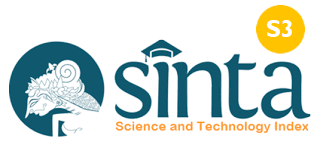Penerapan Ajaran Tri Kaya Parisudha Dalam Pembentukan Perilaku Yang Baik Terhadap Peserta Didik
Abstract
Religion is a quest for mankind in God. Throughout the ages, mankind has always wrestled in its quest for the secrets and the essence behind this life, religion is a means or a way to bridge and provide solutions to solve a problem in this life. There are many ways to reach the ultimate truth: do not hurt anyone, then follow your teacher sincerely, who has the intention of not engaging in conflicts, appreciate unity in difference, the difference is wonderful if you can understand.
References
Ali, Muhamad. 1992. Guru Dalam Proses Mengajar. Bandung : Sinar Dunia
Alwasilah, A.Chaedar. 2002. Pokok Kualitatif, Dasar – Dasar Merancang dan Melakukan Penelitian Kualitatif. Jakarta : PT. Dunia Pustaka Jaya
Arikunto, Muhamad. 1992. Prosedur Penelitian Suatu Pendekatan Praktek. Jakarta : Rineka Cipta
Arikunto, Suharsimi, 2002. Prosedur Penelitian Suatu Pendekatan Praktek (Edisi
Revisi V). Jakarta : Rineka Cipta
Asri, B, 2005. Belajar dan Pembelajaran, Jakarta : Rineka Cipta
Bungin , 2001. Metodologi Penelitian Sosial, Format Kuantitatif dan Kualitatif, Surabaya : Airlangga Univ. Press
Burhanudin, 1990. Analisis Administrasi Manajemen Kepemimpinan Pendidikan,
Malang : Bumi Aksara
Dahar. R.W. 1989. Teori – Teori Belajar. Jakarta : Erlangga
Dahar, Ratna Wilis, 1989. Teori – Teori Belajar. Jakarta : Erlangga
Daradjat, Zakiah. 1970. Peranan Agama Dalam Kesehatan Mental. Jakarta : Gunung Agung
Derajat, Zakiah. 1982. Pembinaan Remaja. Jakarta : Erlangga
Sudarsana, I. K. (2014, September). Membangun Budaya Sekolah Berbasis Nilai Pendidikan Agama Hindu untuk Membentuk Karakter Warga Sekolah. In Seminar Nasional (No. ISBN : 978-602-71464-0-2, pp. 69-75). Pascasarjana IHDN Denpasar.
Sudarsana, I. K. (2013, September). Pentingnya Organisasi Profesi, Sertifikasi dan Akreditasi sebagai Penguatan Eksistensi Pendidikan Nonformal. In International Seminar (No. ISBN : 978-602-17016-2-1, pp. 176-187). Department Of Nonformal Faculty Of Education UPI.
Sugiharta, I. P. S. O., & Sudarsana, I. K. (2017). Hypnotic Learning Characteristics On Sisya Brahmakunta Community In Denpasar. Vidyottama Sanatana: International Journal of Hindu Science and Religious Studies, 1(2), 132-145.
Wiguna, I. M. A. (2018, January). MENGURAI NILAI-NILAI MORAL DALAM SATUA SEBAGAI MEDIA PENDIDIKAN KARAKTER DI ERA GLOBAL. In PROSIDING SEMINAR NASIONAL KEARIFAN LOKAL INDONESIA UNTUK PEMBANGUNAN KARAKTER UNIVERSAL 2015 (pp. 232-241).
Wiguna, I. M. A. (2017, October). Memaknai Mahavakya Sebagai Bentuk Universalitas Veda Dalam Upaya Membangun Semangat Kebhinekaan. In Prosiding Seminar Pendidikan Agama (pp. 93-102).
Wisarja, I. K., & Sudarsana, I. K. (2017). Praksis Pendidikan Menurut Habermas (Rekonstruksi Teori Evolusi Sosial Melalui Proses Belajar Masyarakat). Indonesian Journal of Educational Research, 2(1), 18-26.
Wisarja, I. K., & Sudarsana, I. K. (2017). REFLEKSI KRITIS IDEOLOGI PENDIDIKAN KONSERVATISME DAN LIBRALISME MENUJU PARADIGMA BARU PENDIDIKAN. Journal of Education Research and Evaluation, 1(4), 283-291.
Downloads
Published
How to Cite
Issue
Section
License
An author who publishes in the Cetta : Jurnal Ilmu Pendidikan agrees to the following terms:
- Author retains the copyright and grants the journal the right of first publication of the work simultaneously licensed under the Creative Commons Attribution-ShareAlike 4.0 License that allows others to share the work with an acknowledgement of the work's authorship and initial publication in this journal
- Author is able to enter into separate, additional contractual arrangements for the non-exclusive distribution of the journal's published version of the work (e.g., post it to an institutional repository or publish it in a book) with the acknowledgement of its initial publication in this journal.
- Author is permitted and encouraged to post his/her work online (e.g., in institutional repositories or on their website) prior to and during the submission process, as it can lead to productive exchanges, as well as earlier and greater citation of the published work (See The Effect of Open Access).
Read more about the Creative Commons Attribution-ShareAlike 4.0 Licence here: https://creativecommons.org/licenses/by-sa/4.0/.





